When you dive into the world of music production, you’ll consistently encounter the sequencer.
A sequencer, whether hardware or software-based, allows you to organize and manipulate sounds to create compelling musical compositions.
From live performances to studio productions, these devices help bring your musical ideas to life with precision and creativity.
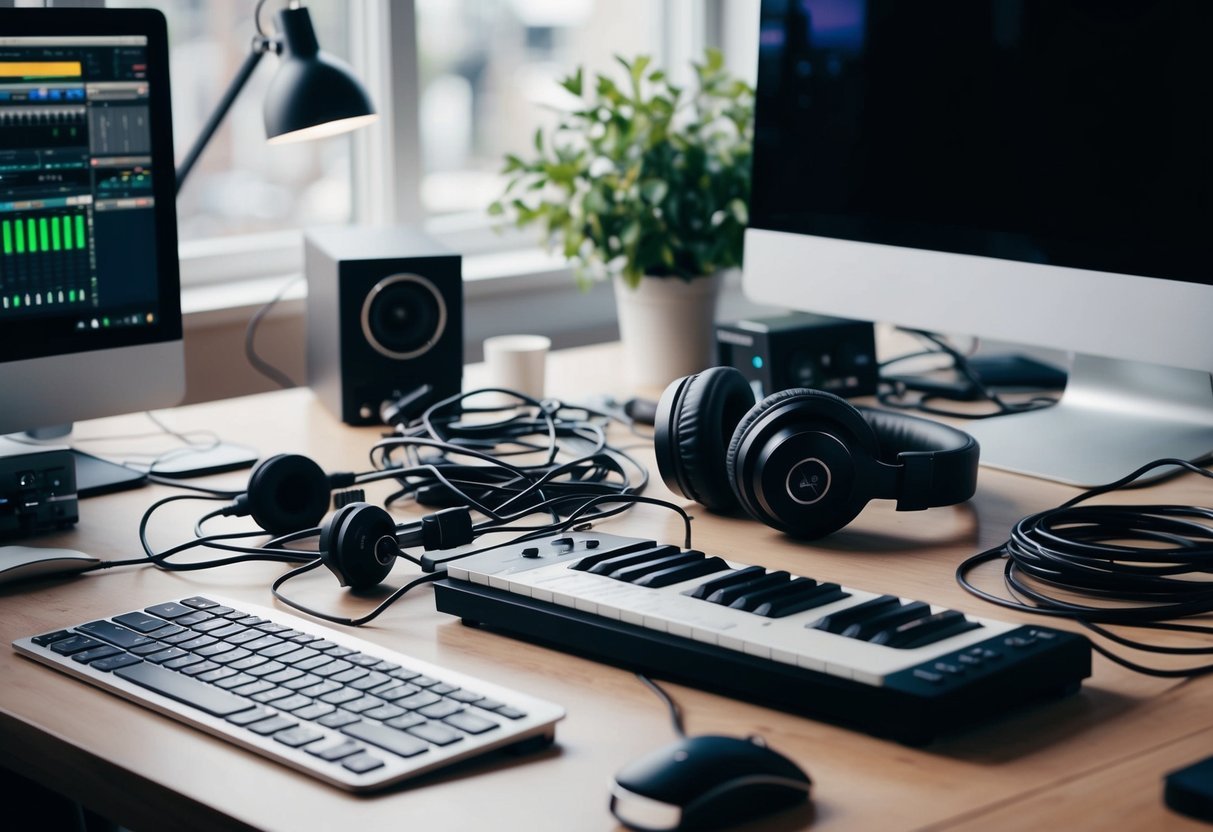
In today’s market, you have a vast array of sequencers at your fingertips.
Whether you’re on the go with a compact device like the Roland MC-101 Groovebox or exploring the expressive capabilities of Squarp Instruments’ Hapax, there’s something to suit every style and scenario.
You’ll find sequencers that cater to professional studio setups as well as those designed to fit snugly within your budget.
As you explore the features of various sequencers, you’ll notice that each offers unique benefits tailored to different musical needs.
Whether it’s the portability, interface, or advanced capabilities, each sequencer brings something distinct to the table, waiting for you to harness its potential in your creative journey.
The Basics of Music Sequencers
Music sequencers are essential tools in modern music production, helping you program, edit, and arrange musical elements.
From step sequencers to MIDI tracks, understanding their functionalities enhances your creative workflow.
Understanding Sequencers
A sequencer is a device or software used to create and manipulate music by arranging musical notes, rhythms, and effects.
Imagine it as your musical notepad, allowing you to record and play back sequences of sound.
Using a sequencer can help you develop complex patterns and arrangements that bring your musical ideas to life.
In digital settings, sequencers often integrate with Digital Audio Workstations (DAWs) through MIDI, enabling precise control over instrument sounds, effects, and dynamics.
With sequencers, you can automate the music creation process, making editing and arranging a breeze.
Types of Sequencers
Sequencers come in various forms, each with unique features and capabilities. Step sequencers let you input notes and effects step-by-step, making them great for creating intricate drum patterns and basslines.
They excel in electronic music production where precision and repetition are key.
MIDI sequencers focus on recording and playing MIDI data, giving you command over electronic and virtual instruments.
They function within DAWs, offering flexibility in manipulation and routing of sound.
Both hardware sequencers, which provide tactile control, and software sequencers, noted for their integration with other digital tools, serve diverse production needs.
Sequencer Components and Signal Path
A typical sequencer consists of several components that work in unison.
The clock defines the timing, ensuring everything stays in rhythm. Track setups might include MIDI and audio tracks, laying the foundation for your musical arrangement.
Using a piano roll interface, you can input and edit notes visually, making it easier to construct melodies and harmonies.
This interface further assists in refining rhythmic components and note velocities within your composition.
Signal path refers to the flow of audio or MIDI data within the sequencer.
Understanding this flow is crucial for effective sound design and arrangement, allowing you to creatively route sounds through various effects and instrument tracks for the desired output.
Digital Audio Workstations (DAWs) and Sequencing
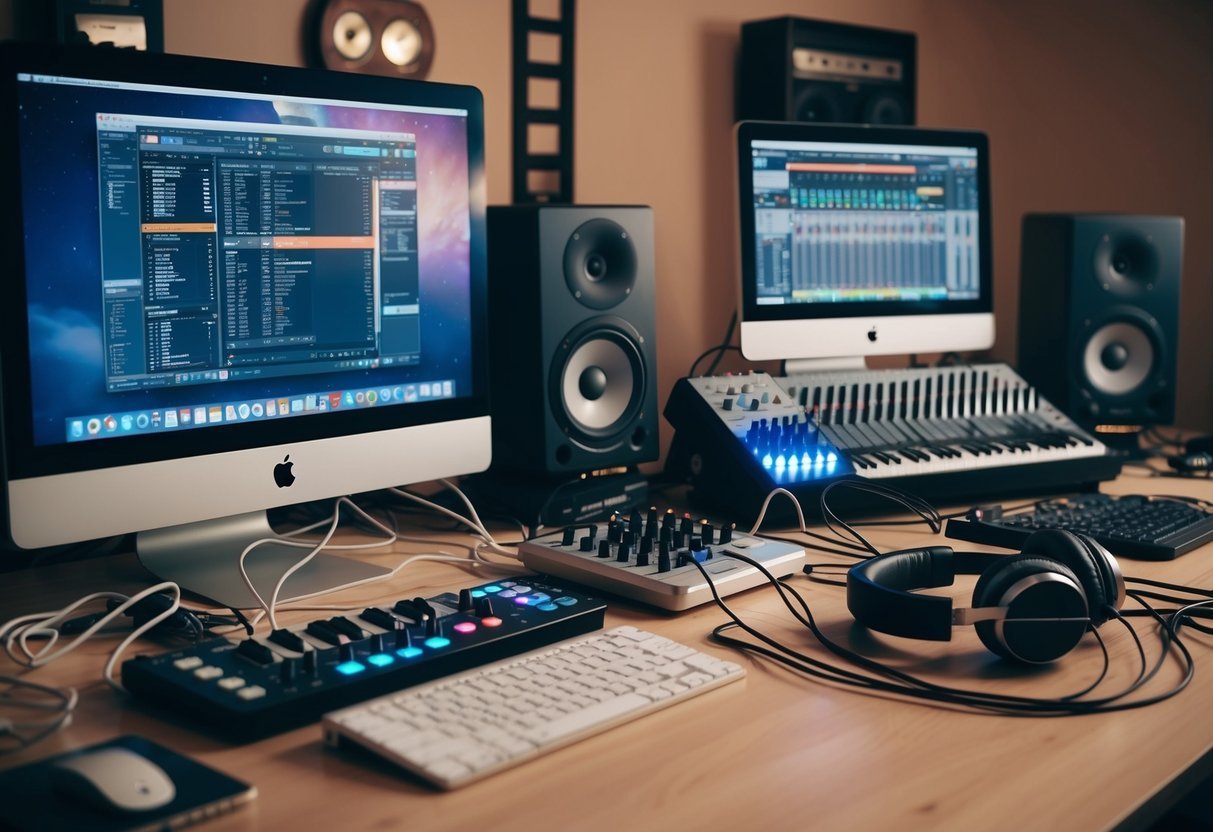
Digital Audio Workstations (DAWs) play a key role in music production by offering sequencing features that allow you to arrange and edit music.
These tools have evolved significantly, with specific features that enhance creative workflows for music producers.
What Is a DAW?
A DAW is software designed for recording, editing, and producing audio files.
It keeps all elements of music production in one place.
Whether you’re tracking vocals, adding effects, or arranging complex compositions, a DAW has you covered.
DAWs like Ableton Live, Logic Pro, Pro Tools, and FL Studio cater to various production needs.
They provide virtual instruments, effects, and sequencing capabilities, serving as a central hub for your music projects.
DAW Timeline and MIDI Editor
The timeline and MIDI editor are crucial for sequencing within a DAW.
They allow for precise control over your musical elements.
The timeline organizes audio and MIDI clips in a linear fashion, facilitating detailed arrangement and editing.
With the MIDI editor, you can manipulate individual notes, velocities, and articulations.
This is especially beneficial if you’re crafting beats or intricate melodies.
DAWs like Logic Pro and FL Studio offer rich MIDI functionalities, ensuring you can shape your musical ideas effortlessly.
Popular DAWs for Sequencing
In the world of sequencing, Ableton Live stands out for its intuitive interface and powerful session view, which lets you experiment with clips and loops dynamically. Logic Pro offers advanced features with its step sequencer and live loops, perfect for crafting detailed arrangements.
For those new to music production, GarageBand provides an easy entry point with basic but effective sequencing tools. FL Studio is renowned for its pattern-based sequencing, making it popular among EDM and hip-hop producers.
All these DAWs bring unique strengths to sequencing, giving you options to match your creative approach.
Hardware vs. Software Sequencers
When diving into music production, choosing between hardware and software sequencers can significantly impact your workflow and creative process.
These tools, whether tactile or digital, offer distinct advantages and challenges.
Understanding these can help you make informed choices for your music projects.
Pros and Cons of Hardware Sequencers
Hardware sequencers, like the Arturia BeatStep Pro or Elektron Octatrack MKII, offer a hands-on experience that many musicians find inspiring.
The physical knobs and pads bring an intuitive feel to live performances and studio sessions.
Devices can function independently, making them reliable in live settings without a computer.
They often integrate well with other hardware like drum machines and MIDI controllers, expanding your creative possibilities.
On the downside, hardware setups can be expensive.
Upgrading means buying new models, unlike software, which can often be updated.
Portability can be a challenge, too, especially with larger equipment like the Akai Professional MPC X.
Each hardware unit may offer unique features, but this also means a varying learning curve for each device.
Pros and Cons of Software Sequencers
Software sequencers like those in Digital Audio Workstations (DAWs) are highly adaptable, providing a wide range of features in one package.
They’re great for those who enjoy visualizing their work, offering detailed editing capabilities on-screen.
The versatility of digital tools allows easy integration with virtual instruments and effects.
You might appreciate their affordability, given many entry-level software versions cost less than hardware.
Upgrading and expanding capabilities is simple with plugins and updates.
However, software sequencers depend heavily on computer performance, which might lead to lag in complex projects.
Also, the lack of tactile feedback can be a drawback if you enjoy hands-on interaction with your music gear.
Integrating Hardware with Software
Combining hardware and software sequencers can give you the best of both worlds.
Using a hardware sequencer with your software setup can add tactile control and ease of live manipulation.
Devices like the Elektron Digitakt work seamlessly with DAWs, letting you trigger samples and manage MIDI sequences easily.
To integrate, connect the hardware via MIDI or USB to your computer, configure settings in your DAW, and start experimenting.
This setup enhances creativity, offering real-time control and flexibility, ensuring that whether you’re producing in the studio or performing live, you have a versatile and dynamic workflow.
The Role of MIDI in Sequencing
MIDI technology is central to sequencing, offering a versatile platform for creating and manipulating music.
It enables precise control of musical elements, from note transitions to complex rhythms.
MIDI Basics
MIDI, or Musical Instrument Digital Interface, is a standard for sending digital data between musical instruments and devices.
With MIDI tracks, you can capture notes, chords, and other musical details.
MIDI doesn’t produce any sound itself but communicates instructions to MIDI instruments, like synthesizers or drum machines.
Using a MIDI keyboard, you can easily input musical ideas.
This way, your sequencing becomes not just easier but also more adaptable to change.
You can rearrange notes or experiment with new sounds without re-recording.
Advanced MIDI Sequencing Techniques
As you get comfortable, explore further sequencing capabilities like automation and tempo changes. MIDI editing allows for detailed control over each note’s velocity, duration, and more.
Use a MIDI editor to adjust these aspects without affecting the original recording.
Creating complex arrangements is a lot simpler when you can copy and paste MIDI segments or apply quantization to align notes precisely.
Many music production software offer customizable MIDI track templates, so you can start quickly and focus on creativity.
MIDI and Electronic Music Production
In electronic music production, MIDI is the backbone for most workflows.
It bridges the gap between software and hardware, facilitating seamless interaction with synthesizers and drum machines.
You can assign MIDI tracks to different virtual instruments, providing a rich tapestry of sounds.
By layering these sounds, you can achieve a more intricate composition.
MIDI also supports the use of plugins that can dramatically change the output, letting you shape innovative sounds.
Creating Beats and Rhythmic Patterns
When diving into beat-making, understanding the essentials of drum patterns, crafting unique grooves for genres like hip-hop and electronic music, and experimenting with timing variations like swing and groove play crucial roles in shaping your music.
Each aspect contributes to distinct rhythmic experiences.
Drum Patterns Fundamentals
To start creating beats, you need to get familiar with drum patterns.
Two elements you’ll often work with are kick drums and snares.
These form the backbone of many tracks.
Kick drums typically set the beat’s pulse, while snares add energy and drive.
Hi-hats can be layered to introduce texture and complexity.
They offer a range of sounds from sharp to soft, giving you flexibility.
Understanding polyrhythms can also be game-changing, as they let you create more intricate patterns by overlapping different rhythms.
Using a step sequencer can make this process easier by allowing precise control over each drum hit and sound element.
When making drum patterns, think about which elements you want to emphasize and how they interact with each other to create cohesive grooves.
Hip-Hop and Electronic Music Grooves
Hip-hop and electronic music offer opportunities to push rhythmic boundaries.
In hip-hop, the groove often revolves around a strong bassline, syncopated rhythms, and creative use of samples.
You can build your grooves by combining drum machines with samples for a signature sound.
Electronic music, on the other hand, often embraces repetitive loops.
Here, evolving elements, synth lines, and timed effects can keep the listener engaged.
Using a step sequencer provides a structured approach, enabling you to easily manipulate sequences and experiment with different effects.
Layering beats and sounds is key.
Think about how combining various rhythmic elements, like claps or shuffles, can add depth to the groove.
Swing, Groove, and Timing Variations
Adding swing to your beats can make them feel more alive and less mechanical.
Swing shifts certain beats slightly off the grid, creating a more relaxed, human feel.
When applying swing, you’re deciding how much to deviate from the strict timing to achieve a desired groove.
Groove emphasizes the space between the notes, providing a syncopation that can enhance a track’s character.
Each genre may require different groove settings.
Timing variations elevate your beat-making.
By playing with rhythm, you can introduce unexpected polyrhythms or accented beats that grab attention and add uniqueness to your music.
Incorporating these elements gives your tracks a distinctive flavor and can set them apart.
Performance and Real-Time Sequencing
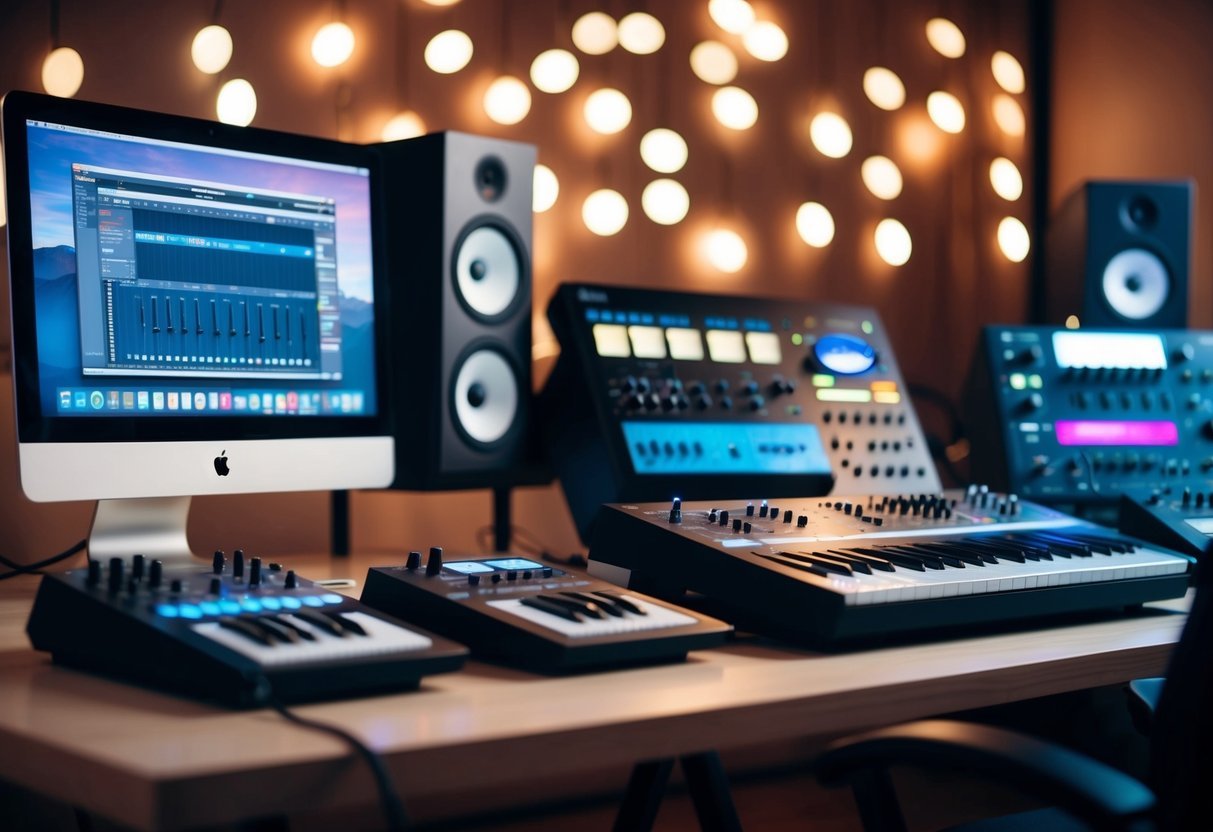
Integrating sequencers into live setups enhances both structured and spontaneous performances.
With capabilities like real-time recording and expressive controls, musicians can transform their music on stage.
Live Performance and Sequencers
When you incorporate sequencers in your live performances, you’re opening up a world of flexibility.
Sequencers provide the ability to loop patterns and edit them on the fly.
This means you can build complex layers gradually without missing a beat.
Grooveboxes and velocity-sensitive pads are particularly useful, enabling you to trigger samples with the dynamics you want, making your set more expressive.
Expect instant responsiveness as you cue in drums, synths, and other samples in sync with your music.
Such tools are especially valuable for electronic genres, where real-time manipulation of beats and melodies is often key.
Improvisation and On-the-Fly Sequencing
Improvisation becomes a thrilling experience with real-time sequencing.
You can adjust the sequences while performing, allowing your creativity to flow freely.
MIDI controllers and grooveboxes facilitate on-the-fly adjustments without interrupting the musical flow.
By using sequencers with real-time recording capabilities, you’re able to capture ideas as they occur and integrate them into your existing tracks.
This is ideal for spontaneous moments, keeping your audience engaged as your performance evolves in real-time.
Programming Melodies and Harmonies

Explore the essential techniques for crafting compelling melodies and harmonies in your music.
Understanding note placement, building chord progressions, and using scales and modes will help you create richer compositions.
Note Placement and Melody Building
When it comes to creating melodies, note placement is crucial.
Think about the emotional impact of each note in your sequence.
You want to experiment with varying note lengths and rhythmic patterns to add texture.
Don’t be afraid to move notes around to change the flow.
Use pizzicato for a plucky sound or legato for a smooth transition between notes.
An important tip is to make melodies repeatable to create a hook.
Melodies often work best when they are simple yet memorable.
Chord Progressions and Layering
Chords are the backbone of your music and provide emotional depth.
Start with basic triads and experiment with major and minor chords.
Layering chords involves stacking harmonies to create a fuller sound.
Try adding a bassline that complements your chords to add richness.
Use inversions to change the feel, keeping your listeners engaged.
Layer strings or synths above simple chords to create a lush, cinematic effect.
Texture is key, so experiment with different instrument sounds.
Working with Scales and Modes
Scales and modes form the language of your music.
Start with the major scale for a happy tone or the minor scale for something a bit sadder.
Modes like Dorian or Lydian can add unique flavors, giving your melodies a distinct identity.
Changing modes can transition your piece to a different emotional state.
Use a pentatonic scale for simplicity and catchiness, which is great for solos.
Scale choices can help you define the mood and atmosphere of your composition, so choose wisely to fit the vibe you want to create.
Editing and Automation in Sequencing
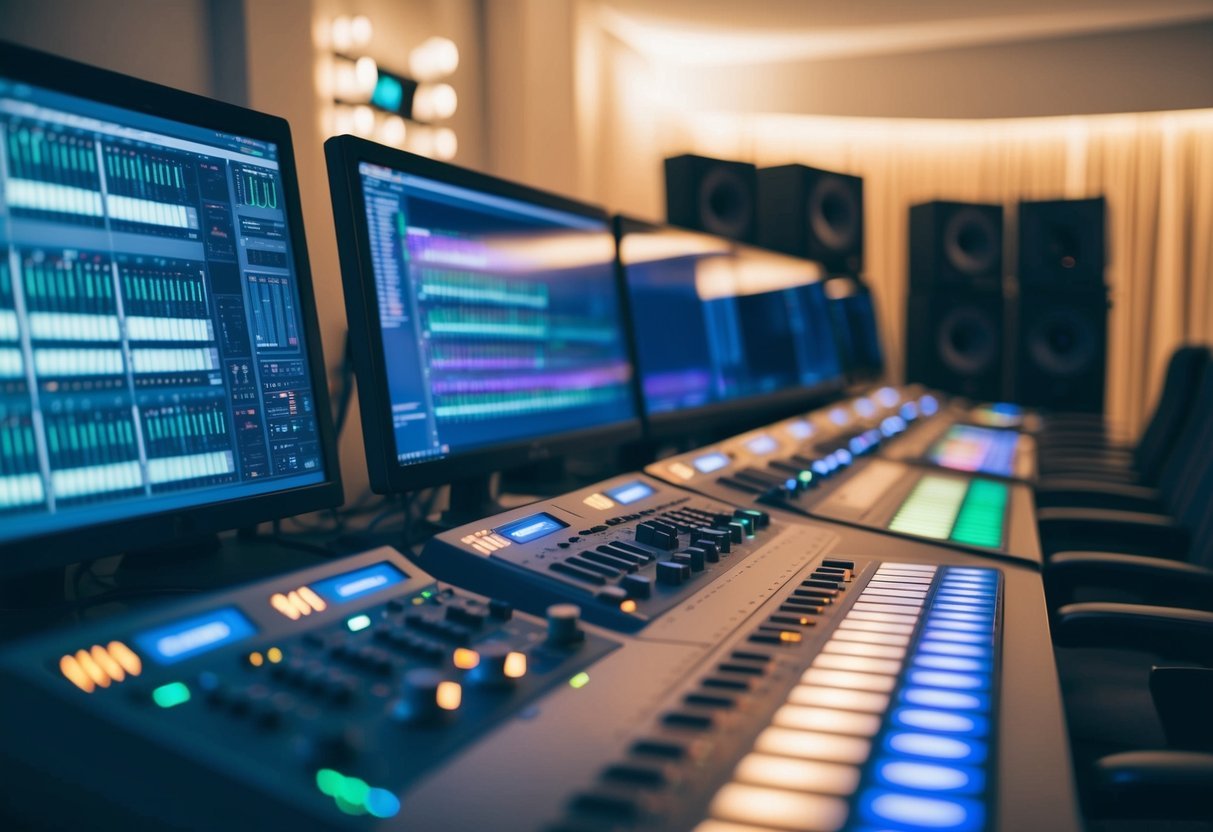
In digital music production, sequencers give you the power to customize and control every aspect of your music.
By fine-tuning MIDI events and automating effects and parameters, you can craft tracks that are both precise and dynamic.
Fine-Tuning MIDI Events
Fine-tuning MIDI events in your sequencer is all about getting the perfect sound.
You’ll want to adjust various elements like note velocity and the timing of note events to shape your track.
This involves altering how hard or softly notes are played, influencing the dynamics and feel of the music.
You can also dive into modulation to add movement to your sounds.
This can be done through tweaking parameters like pitch or filter settings throughout your composition.
Time-stretching MIDI events is another useful tool.
It allows you to align notes without affecting their pitch, ensuring your music flows seamlessly with the rhythm.
Automation of Effects and Parameters
Automation in sequencers lets you bring life to your music by controlling effect parameters over time.
Think of tailoring a song’s reverb, adjusting it gradually for more depth, or tinkering with filter cutoffs to create evolving textures.
Try automating the volume levels of tracks to help individual sounds fit perfectly together.
Automation can be applied to almost any parameter, from EQ settings to delay feedback, enabling you to sculpt every moment of your track.
By setting automation curves, you’re effectively creating a blueprint for how your mix will change over time, offering endless possibilities for creativity.
Sampling, Sound Design, and Sequencers
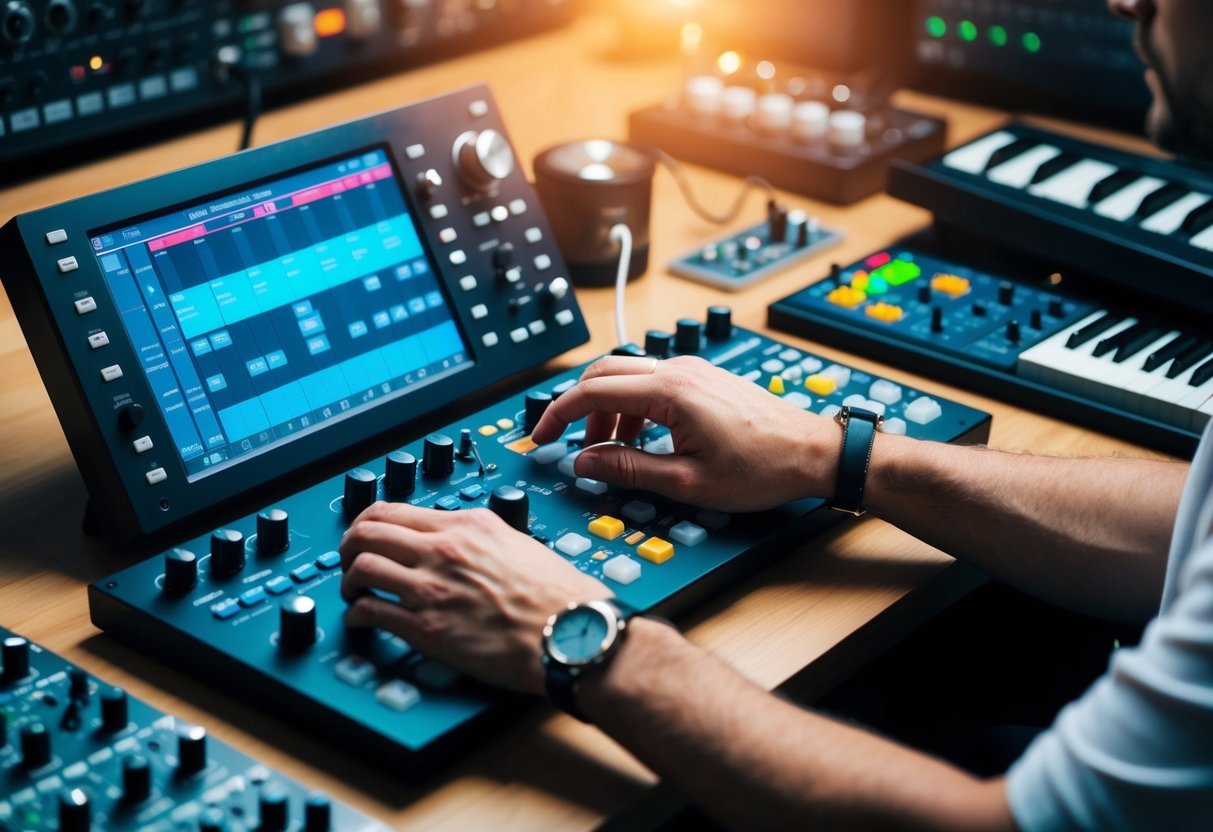
When it comes to music production, sequencers play a vital role in shaping unique sounds through sampling and sound design.
They allow you to manipulate audio samples, create innovative soundscapes, and seamlessly integrate these elements into your projects.
Creating Unique Sounds with Samplers
Samplers are a fundamental tool for crafting distinctive sounds.
By taking an existing audio sample, you can chop, layer, and rearrange it to create something entirely new.
Whether it’s a snippet of a vintage record or a field recording, samplers let you explore endless sonic possibilities.
Using a sequencer with a sampler, you can precisely control playback timing, transforming mundane sounds into rhythmic patterns or melodic sequences.
This opens the door to creativity, enabling you to compose tracks that have a signature sound.
Pitch Shifting and Sound Manipulation
Pitch shifting is a powerful technique within your sound design arsenal.
By altering the pitch of an audio sample, you can generate exciting variations of a sound without changing its speed.
This method is particularly useful for adapting samples to fit different harmonic contexts or musical genres.
Sound manipulation extends beyond just pitch.
With effects like time-stretching, reverse playback, and modulation, you can entirely reshape the character of a sample.
Using a sequencer helps automate these processes, allowing you to experiment with intricate sound manipulations effortlessly.
Integrating Samples into Music Production
Integrating samples into your music production process can add depth and textures to your compositions.
Sequencers allow you to arrange these samples across your track, structuring them rhythmically or melodically to suit your song’s dynamics.
Whether you’re working within a DAW or using hardware, the integration process is streamlined, giving you control over each sample’s timing and effects.
This precision can be the difference between a track that feels glued together and one that feels disjointed.
By interacting with samples through sequencers, you unlock the potential to weave cohesive musical narratives that capture your creative vision.
Connectivity and Expansion
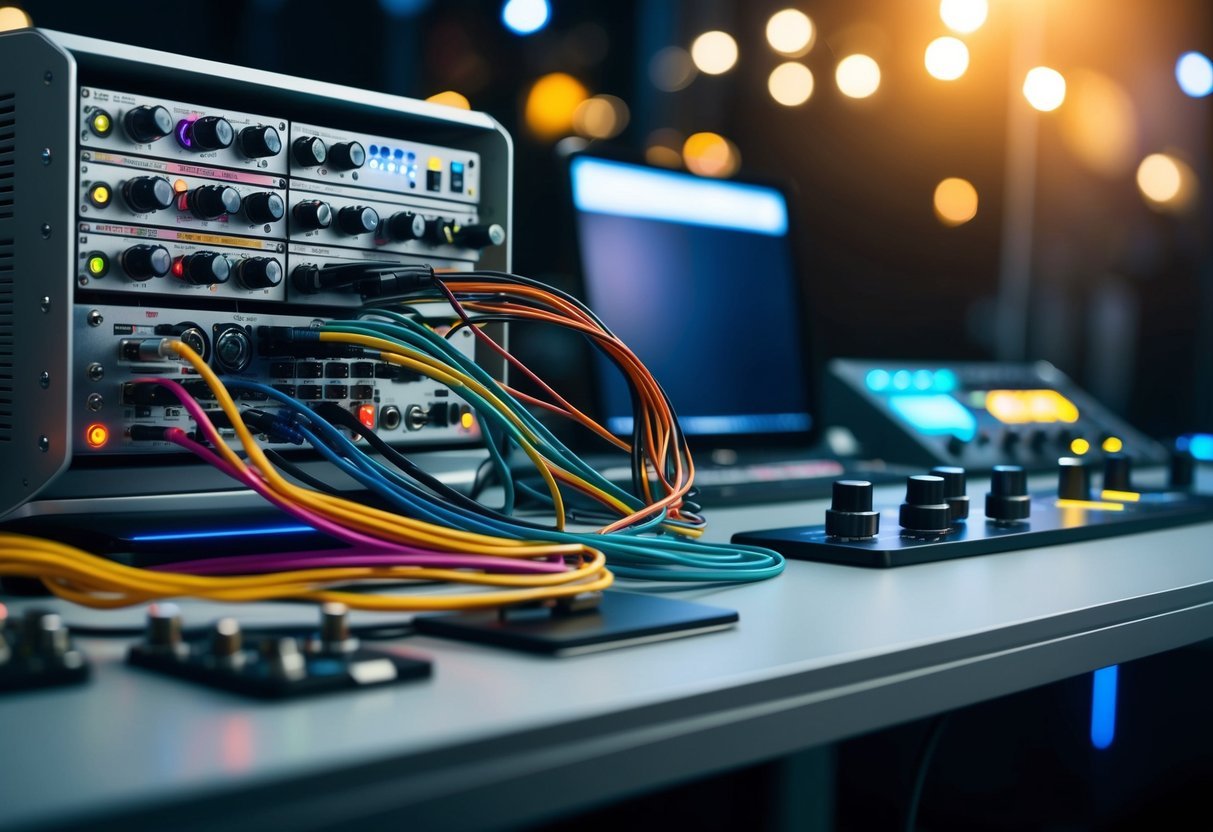
When diving into music production, it’s crucial to understand how to connect and expand your setup.
This involves combining various external gear and integrating MIDI and CV outputs.
You’ll find ways to unleash the full potential of your sequencer by linking it with other music gear, and exploring the nuances that MIDI and CV outputs offer.
Working with External Gear
Connecting your sequencer to external gear can transform your music-making experience.
You’ll often find standard MIDI In, Out, and Thru ports offered by sequencers like the Elektron Digitakt, enabling you to hook up multiple MIDI devices.
For modular synth enthusiasts, the Keystep Pro is a fantastic choice, as it offers a range of analog I/O options, including pitch, gate, and velocity CV outputs.
Eurorack setups also typically benefit from these connections, allowing you to experiment with various modules.
Using MIDI instruments with sequencers expands your sound palette, providing endless sonic possibilities.
Look for gear with USB connectivity if your setup includes laptops or other digital devices to keep everything integrated smoothly.
Exploring MIDI and CV Outputs
MIDI and CV outputs are your primary tools for controlling other devices.
Most sequencers, like the Elektron Octatrack, feature multiple MIDI tracks allowing for layered and dynamic control over your instruments.
Explore the use of MIDI effects to enhance the expressive qualities of each track, catering to creative needs across genres.
CV outputs extend this control to the realm of analog synthesizers and Eurorack setups.
This lets you tweak parameters directly, creating organic and evolving soundscapes.
CV compatibility is vital if you’re aiming to build a modular environment, providing the flexibility to shape your sonic experiments easily.
Innovations and Future of Sequencing
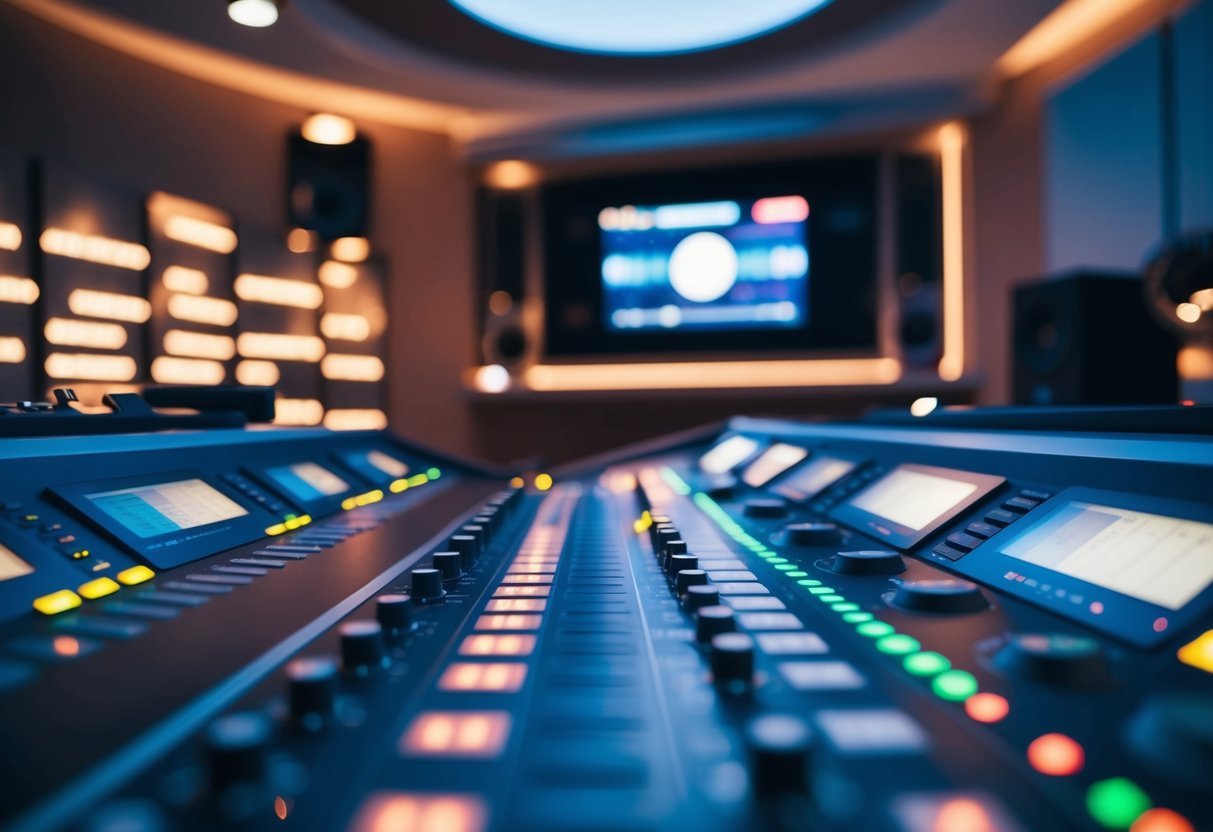
The landscape of music sequencing is constantly evolving, driven by technological advancements that enhance creativity and efficiency.
New trends and AI’s influence are reshaping how you interact with sequencers and create music.
New Trends in Sequencer Technology
Sequencers are seeing exciting upgrades.
Multi-touch screens are becoming more prevalent, offering a more interactive and intuitive experience.
Devices like MPC One have integrated these screens, allowing you to manipulate patterns with ease.
Grid-based interfaces are another trend.
They offer a visual approach to music composition, helping you map out beats and notes efficiently.
Built-in sequencers in synths and samplers give you the flexibility to craft music directly from the device, making them indispensable in a modern music production system.
Standout devices like standalone samplers incorporate various tools into a single package.
You can manage everything from pattern length to LFO settings, all within a single compact unit.
The Impact of AI on Music Sequencing
AI is changing how you approach sequencing in music production.
It’s introducing smarter systems that adapt to your style and preferences.
Some sequencers now use AI to suggest complementary patterns or rhythms based on your current project.
AI-powered features can streamline repetitive tasks, helping with tasks like adjusting note velocities or refining timing.
This integration not only speeds up the workflow but also encourages exploration and experimentation.
AI’s adaptive learning capabilities can enhance improvisation, offering real-time suggestions based on evolving music patterns.
By incorporating machine learning, sequencers can now provide personalized experiences tailored to your unique style, pushing the boundaries of what’s possible in music creation.
Frequently Asked Questions

Sequencers are essential tools in music production, whether you’re crafting complex rhythms or melodic sequences.
Understanding their types, features, and applications can greatly enhance your creative workflow.
What should you look for in a good sequencer for making beats?
When you evaluate sequencers for beat-making, focus on features like user-friendly interfaces, flexibility in timing and rhythm, and strong integration with other equipment.
A good sequencer should also offer plenty of customization options and support re-sampling and pattern storage.
These features help to facilitate creativity and efficiency.
How does a step sequencer differ from a traditional MIDI sequencer?
Step sequencers let you create music by inputting notes and rhythms one step at a time, often using a grid interface.
This provides precise control over timing and repetition.
In contrast, MIDI sequencers record and play back live input from a keyboard or controller.
They capture your performance in real time for a more dynamic feel.
Can you recommend some popular hardware sequencers used in music production?
Popular hardware sequencers include the Elektron Digitakt, known for its powerful sampling capabilities and intuitive interface.
The Korg SQ-1 is a great choice for its simplicity and versatility.
Both offer robust features that appeal to producers who enjoy hands-on music creation without relying entirely on computers.
Is a MIDI controller necessary for using sequencer software?
A MIDI controller isn’t strictly necessary for using sequencer software, but it can greatly enhance your workflow.
Controllers allow for more expressive input and can speed up the process of laying down tracks.
Without one, you’ll rely on clicking or drawing notes in the software, which can be less intuitive and slower.
What are the beginner-friendly features in music production sequencers?
Sequencers with features like drag-and-drop functionality, built-in sound libraries, and visual interfaces make it easier for beginners to get started.
Look for those with step-by-step tutorials or community support to help guide you.
Simplified control layouts and automation support can also reduce the complexity and make learning more approachable.
How does sequencing in music production enhance your tracks?
Sequencing helps structure your musical ideas with precision.
It also enhances the arrangement and complexity of your tracks.
It allows you to experiment freely with arrangements, timing, and effects.
With a sequencer, you can easily add layers, automate changes, and tweak compositions.
This brings depth and character to your music.

